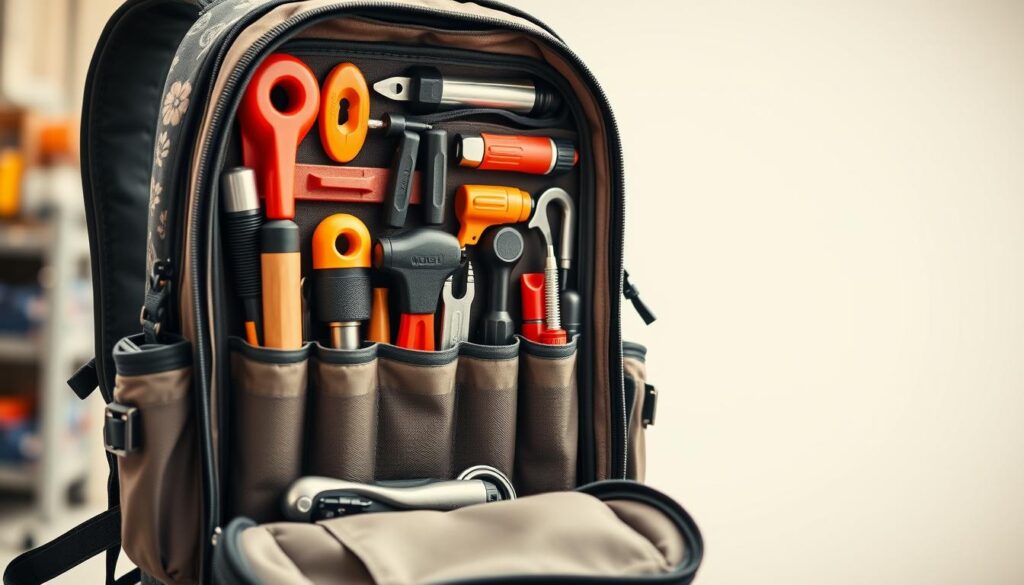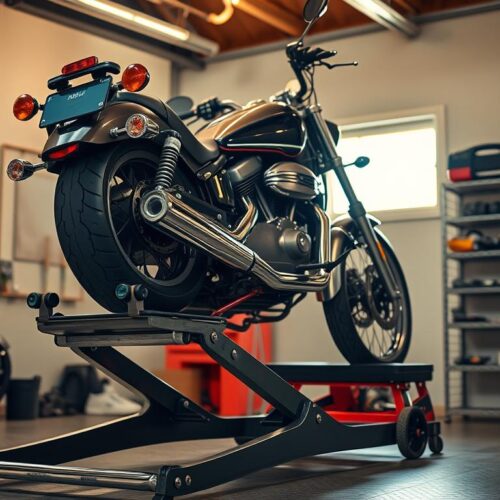In an unpredictable world, having an emergency tool backpack is key. Whether dealing with natural disasters or daily roadside issues, knowing what to pack is crucial. This kit is a way to be ready ahead of time. It gives you the essential tools to handle surprises. From simple fixes to complex roadside repairs, being prepared lets you face challenges confidently.
Understanding the Purpose of a Tool Backpack
A tool backpack is crucial for various situations. It acts as a center for your must-have travel items. Its main job is to offer a specific place for storing important emergency supplies, whether you’re on a trip or at home. When you’re in a pinch, a well-stocked tool backpack lets you quickly grab the tools you need for basic fixes.
Getting a good tool backpack prepares you for the unexpected and helps keep your things in order. This investment is especially valuable when you need to do repairs on the go or regular upkeep tasks. With the proper setup, your tool backpack becomes more than just storage. It turns into a movable emergency kit, making you ready to handle urgent situations efficiently.
Essential Tools for General Repairs
When you’re packing your tool backpack, it’s key to think about the must-have tools for fixing stuff. Your toolkit needs items for both everyday fixes at home and emergencies on the road. Start with screwdrivers in flathead and Phillips types because they’re super useful for taking things apart and putting them back together.
Then, be sure to add different wrenches, as they’re essential for working on nuts and bolts. Pliers are also a must-have since they let you grab, twist, and cut easily. A multi-purpose tool is great too. It does lots of things while saving space in your backpack.
Experts in emergency management advise having tools that are both handy and light. Choose tools that are easy to carry but strong. With these essential tools, you’ll be set to handle most repairs. This means you can be independent and ready for anything.
Safety Gear You Shouldn’t Ignore
Safety gear is key when doing repairs or when surprises pop up. It lets you work safely and get things done faster. Your emergency kit should always have:
- Goggles: Protect your eyes from debris and harmful substances.
- Work gloves: Shield your hands from cuts and abrasions.
- First-aid supplies: Treat minor injuries without delay.
- Reflective vests: Increase visibility in low-light conditions.
Spending money on these items makes you ready for different situations. Some safety gear, like masks, keep moisture and dust away. Strong gloves help you hold things firmly and safely. Each part of your safety gear helps lower risks while you work.
Organizational Tips for Your Backpack
Efficient tool backpack organization is key to finding your tools fast during emergencies. When packing, sort your items like first aid, general tools, and outdoor gear. This makes it quick to grab what you need.
Using different compartments and pouches helps a lot. Color-coded labels or zip-lock bags make items easy to spot fast. These organizational tips help you avoid wasting time searching in your backpack, so you stay focused.
Here’s a table to illustrate how you might organize your tools for maximum efficiency:
| Category | Items | Storage Method |
|---|---|---|
| First Aid | Band-aids, antiseptic wipes, gauze | Small pouch with a red label |
| Hand Tools | Wrenches, screwdrivers, pliers | Tool roll or specified compartment |
| Outdoor Gear | Flashlight, matches, rope | Zip-lock bags in a separate section |
| Emergency Equipment | Whistle, compass, emergency blanket | Compartment that’s easily accessible |

Keeping your tool backpack organized means you’ll find what you need faster in emergencies. Good organization is crucial, especially in urgent situations.
Recommended Hand Tools for Emergencies
In emergencies, the right hand tools are key. Pack a multi-tool, adjustable wrenches, a hammer, and a utility knife in your backpack. These tools help with different tasks, from quick fixes to tougher jobs.
A multi-tool packs several uses into a tiny package, ideal for many tasks. Adjustable wrenches adjust to various bolt sizes. A good hammer is useful for driving nails or other needs. A sturdy utility knife makes precise cuts in different materials.
Picking quality hand tools gets you ready for any issues while traveling. Having these key items boosts your preparedness. This greatly helps you handle emergencies better.
The Importance of Power Tools
Hand tools are useful, but power tools are essential, especially in emergencies. Tools like circular saws and drills increase your efficiency when time is tight. In events like natural disasters, power tools speed up tasks that manual tools would slow down.
Adding power tools to your toolset improves your ability to handle tough jobs. Knowing when to use them can change the outcome. For example, a portable generator quickly brings back power, and a drill fastens things needing quick fixes.
Make sure your backpack has enough batteries or chargers. Power tools need constant energy to work well in emergencies. Having charged batteries or power access cuts the risk of tool failure and gets you ready.
Fasteners and Fixatives to Keep Handy
Keeping fasteners and fixatives in your emergency backpack is key. Screws, nails, duct tape, and zip ties help with quick, secure repairs. These items are a must for emergencies or DIY tasks. They fix problems fast, stopping them from getting worse.
Consider adding these important items to your pack:
- Screws: They come in many sizes and are good for putting together furniture or keeping things in place.
- Nails: Great for wood repairs, nails are essential for lots of fix-it jobs.
- Duct Tape: Strong and flexible, duct tape fixes tears and binds things temporarily in almost any case.
- Zip Ties: Ideal for tying things together, zip ties are perfect for organizing cables or temporary fixes.
For better repair work, keep your fasteners and fixatives in a container with labels. This keeps you organized so you find what you need quickly. With the right items on hand, you’re ready for anything unexpected.
| Fastener/Fixative | Typical Uses | Advantages |
|---|---|---|
| Screws | Assembling, securing components | Strong hold, reusable |
| Nails | Quick surface attachment | Fast to use, minimal tools required |
| Duct Tape | Surface binding, repairs | Water-resistant, versatile |
| Zip Ties | Securing loose items | Easy to use, adjustable |
Outdoor and Survival Tools to Consider
When you pack your emergency backpack, include outdoor and survival tools. They’re vital for hikes or trips to remote places. These tools improve your readiness and help you face nature’s challenges.
Some important outdoor tools are:
- Compass: A reliable tool to guide you in unknown areas.
- Survival Knife: Useful for many tasks like cutting rope or making food.
- Fishing Gear: Gives you a way to catch food when needed.
- Fire-Starting Tools: Important for keeping warm and cooking, especially in bad weather.
Having these survival tools in your backpack increases your safety and comfort during outdoor surprises. They let you deal with nature’s tests, making your adventure better.

Technology Tools to Carry for Modern Needs
In our fast-changing world, having tech tools in your emergency kit is vital. These tools boost your ability to handle different problems well. Think about adding portable chargers, satellite devices, and GPS to your kit. They help you stay in touch and find your way in tough times.
Choose tech tools that are reliable and tough. Battery-powered gadgets could be your lifeline when there’s no power. Having a way to recharge them is just as crucial for emergencies.
Below is a table that lists some key tech tools for your emergency kit:
| Tool | Functionality | Key Features |
|---|---|---|
| Portable Charger | Power your devices | Fast charging, multiple ports |
| Satellite Phone | Reliable communication | Global coverage, rugged design |
| GPS Device | Navigation assistance | Waterproof, topographic maps |
| Multi-tool with USB | Versatile functionality | Multiple tool options, rechargeable |
Adding these tech tools to your kit puts you ahead in dealing with emergencies. You’ll be prepared to face today’s challenges.
Tips for Regular Backpack Maintenance
Keeping your tool backpack in good shape is key. A backpack that’s well-cared for lasts longer and is always ready for emergencies. Make sure to follow these tips for the best care:
- Inspect tools for wear and tear. Look for rust, missing parts, or any damage. Replace damaged tools right away to stay prepared.
- Check your emergency kit often. Make sure your first-aid supplies are up to date. Replace any expired medications and items that are missing.
- Keep food fresh. Check the expiration dates on snacks and other perishables. Replace anything that has expired.
- Clean your backpack. Remove dirt and debris inside and out. Keeping it clean stops material from breaking down.
- Sort your stuff. Reorganize your backpack’s contents to make sure everything is easy to find in an emergency. Being organized means being ready.
Just a little time spent on backpack care every few months helps a lot. Regular checks stop the rush during emergencies, ensuring you have what you need.
Expanding Your Tool Collection Over Time
Building your tool collection can start slowly. Begin with a basic set of tools. This base is important for what comes next. As you get better and your projects grow, think about what tools you need next. This way, your tool kit always fits the job, making you ready for anything.
When you’re more experienced, find tools for the tasks you do a lot. This makes your tool kit better suited for your work, making tasks easier. Choosing high-quality tools is smart. They’ll last longer and save you time and work later on.
Final Checklist for Your Tool Backpack
Make sure your tool backpack is ready for anything by checking off this list. It has everything you need, from tools for fixing things to safety gear and outdoor survival tools. By checking everything off this list, you’ll be fully prepared.
Start with the basics for your tool backpack. This includes hand tools like screwdrivers, pliers, and wrenches. You’ll need these for repairs. Also, wear safety gear such as gloves and goggles to stay safe.
Also, pack screws, nails, and adhesives. These fasteners are necessary for many repair jobs.
Add tech tools for modern problems, and don’t miss out on outdoor survival tools. These items could save you in a pinch. Following this checklist ensures you’re ready for anything. It also gives you confidence that you have all you need for emergencies.




